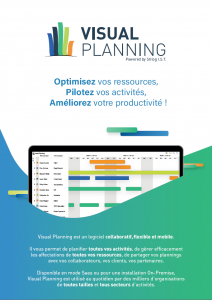A key aspect of project management is properly managing the distribution of resources to complete tasks efficiently, on schedule, and on budget. However, scheduling resources—which include people, equipment, or facilities—is often a complex task.
It involves scheduling and allocating resources based on resource capacity, availability, and effort, as well as project plan and scope. Organizations and managers run into trouble by either over-allocating resources or under-allocating them, which can impact profitability, client satisfaction, employee trust, or relationships with third-party vendors.
Effective resource scheduling helps solve problems associated with resource availability and work capacity in various ways. Here are the key benefits of resource scheduling in project management, seen after implementing a software like Visual Planning into your current projects and operations.

1. BETTER ORGANIZATION
These benefits of resource scheduling software help you organize all aspects to effectively plan and complete the project. Projects often include various teams, departments, locations, vendors, and resource types.
DEFINE THE PROJECT
The first step to scheduling resources is to define the scope of your projects. List all the individual tasks needed to complete the project, and every job involved with completing each task. One of the many benefits of resource scheduling is being able to clearly define your current and future obligations.
DETERMINE THE PROJECT TIMELINE
Next, you need to estimate the time duration and effort for each step of the project. This may include the number of hours, days, or weeks a task will take, the amount of manpower needed for each task, or the percentage of usage required. Time is one of the most valuable resources in your pool, and is a key factor of efficient planning.
IDENTIFY CONSTRAINTS
Each task will have constraints, so it’s important to plan for them. Examine each task for any specific restrictions. It could be a deadline, specific skills required, time of day work needs to be done, weather restraints, or other dependencies. Successful completion depends on your ability to address and revise setbacks, so it is vital to identify all preliminary limitations and resource gaps at the start of the process of resource planning.

2. SMART TASK DISTRIBUTION
Once you know all the tasks and jobs involved with the project, you have to distribute those tasks among your team. But distributing tasks evenly isn’t always the best solution. One of the major benefits of resource scheduling tools is that they can instead help leaders understand how their resources interact and empower them to distribute tasks equitably and with purpose.
RESOURCE ALLOCATION
The first step in smart task distribution is identifying the resources needed to complete every task of the project. This includes looking at your consumable and reusable resources and determining the quantity required or the total effort needed for the tasks.
DETERMINE AVAILABILITY
Next, check the availability of the resources required. This includes looking at the equipment needed for each task and whether that equipment is being used or will be needed for other projects.
As for people, you’ll need to track their availability as well. A scheduling platform makes this task more efficient because it enables you to determine when additional resources are needed, respond to time-off requests accurately, and find replacements quickly without disrupting output or delaying tasks.
MATCH CAPABILITY WITH TASKS
You not only match resources with tasks based on availability within your resource plans, but also capability. Consider the strengths and weaknesses of workers. While one worker may be available for a task, another person may have the skill to do the task faster, so you may need to schedule the task around their availability to meet deadlines.
A good way to manage this is having a resource capability database, which records the specific skills, abilities, and attendance of employees at an individual level. It will help you schedule your human resources faster and easier.

3. BETTER ESTIMATES
Sometimes project managers make incorrect estimates on time and budget without properly evaluating their ability to meet those estimates. Instead of guesswork, these resource scheduling benefits will help you make accurate estimates.
EVALUATE HISTORY
Estimates are complicated, especially when done with traditional methods. Many project managers make these evaluations manually either by firsthand knowledge, guesswork, feedback from the team, or spreadsheets. It all leads to imprecise estimates.
When you use a scheduling platform, it provides reports and analysis of past project lifecycles. You can review how long similar projects took, the track record of employees on certain tasks, and the number of resources needed.
MAKE ADJUSTMENTS
You’re unlikely to have unlimited resources or time, so you’ll have to make adjustments. You should prepare for those issues in your estimates. There are primarily two ways to reconcile limits and constraints: resource smoothing and resource leveling.
When you’re under time constraints, such as when a project has a definite deadline, resource smoothing delays some work and removes flexibility, but it is usually more efficient and cost-effective. Resource leveling is used when you have restraints on the availability of resources. In this method, start and finish dates are adjusted based on resource constraints.
In most situations, you’ll use a combination of smoothing and leveling to complete the project on time.

4. REAL-TIME DATA AND ANALYSIS
Monitoring resource consumption in a project is critical to timely delivery and cost efficiency, as well as the success of future projects. Using technology to monitor your project in real-time provides key data and analysis.
TRACK PROJECTS
Since resources and employees assigned to a project may be in different locations or on different teams, it’s important to have a centralized system that provides full visibility into how resources are being used.
Resource management software provides these insights to help you see how the project is progressing in real-time with daily reports. Especially in the case of shared resource utilization and sequential task dependencies, it is vital to remain on top of your project’s status.
BE READY TO RE-ALLOCATE
No matter how well you initially allocated your resources, projects change along the way. With proper real-time analysis, you can see if you have over-allocated or under-allocated your resources.
Realizing these issues immediately allows you to make informed decisions on necessary adjustments without sacrificing delays in the project or increasing labor cost by paying overtime because workers are taking on more tasks than necessary.
ANTICIPATE DELAYS
Sometimes delays are necessary for various reasons. Data analysis can help you predict them in advance and adjust deadlines well ahead of time instead of at the last minute. Last-minute deadline adjustments can leave you scrambling to re-allocate resources and can cause even longer project delays.

5. PLAN IN ADVANCE
Resource scheduling helps you plan ahead for future projects by anticipating future capacity and demand. Here are some ways it helps you prepare.
MONITOR DEMAND
Proper scheduling allows you to evaluate which resources are in high demand. You can schedule your projects well ahead of time and delay future tasks based on constraints you anticipate.
UNDERSTAND TRENDS
Resource scheduling also involves evaluating trends. You take into account seasonal highs and lows and adjust your scheduling to anticipate bottlenecks and low activity periods.

6. ENHANCE EMPLOYEE ENGAGEMENT AND PRODUCTIVITY
Resource scheduling benefits don’t stop at your bottom line, they empower each and every employee at your company to do their best work. In turn, you can reap the benefits of engaged and productive employees.
IMPROVE EMPLOYEE SATISFACTION
Creating a reliable project schedule ensures that employees are not over or underqualified for their task lists, and feel empowered to utilize their unique skill sets. By allowing employees to do work they are passionate about and good at, they are more likely to remain engaged and retained at your company. Similarly, with an effective resource management tool, you can ensure employees are not overloaded with an overwhelming amount of work, and can still complete project demands effectively with a positive outlook.
IMPROVE EMPLOYEE TRUST
Resource planning also improves employee trust. When you have an accurate system, it doesn’t put any undue burdens or demands on employees. They trust the schedule because it gives them proper insight into busy times so they can plan days off well in advance. This improves the work environment and employee accountability.
INCREASE EMPLOYEE EFFICIENCY
When dealing with a critical resource such as employee labor, it is vital to ensure your teams conduct efficient utilization across all projects. Not only is it important to complete a project on time, but it is also necessary to consider the efficiency of your employees in the long-term. If employees feel burnt out, you are likely to experience efficiency gaps and poor project performance as they are not empowered to do their best work. Even worse, stressed employees may decide to leave your company, putting your company at risk for experiencing skill shortages. By utilizing a reliable resource schedule, you can maintain maximum efficiency across all project tasks.

7. IMPROVE CUSTOMER SATISFACTION
This benefit of resource scheduling software is often overlooked, yet customer relationships are the backbone of your business. By efficiently scheduling your projects, employees and other resources, you can enhance your brand image and strengthen relationships with your client base.
PROVIDE REAL-TIME UPDATES
Enhance client relationships by utilizing all of the data provided in your resource planning software to provide accurate updates when necessary. A wide range of metrics are at your disposal with effective resource planning, so you are not only limited to reviewing task progress. Even if you experience delays, your customers can still perceive your work as a successful delivery if communication is constant and transparent.
REDUCE WASTE OF TIME AND RESOURCES
By ensuring you effectively schedule employees and materials throughout the resource scheduling process, your client relationships will flourish. When projects are completed on time, at or under the project budget, and the quality of product is maintained, your customers are bound to appreciate the effectiveness of your processes.
INCREASE PROFITS
Improving customer relationships also helps you meet your personal company goals, as satisfaction leads to retention. If your customers are happier with your performance, they are more likely to hire you again for additional projects. Additionally, if you practice effective allocation and are able to produce the same quality product at a lower cost, you can pass those savings on to your customer, improving their profit margin in the process.
THE IMPORTANCE OF RESOURCE SCHEDULING
Resource scheduling is essential to project management. Without proper resource scheduling, projects don’t meet deadlines, go over budget, and put added strain on employees and resources.
The process can be complex, but a resource scheduling platform makes it easier by helping you identify resource availability and capacity, properly allocate resources, make better estimates, and analyze data for better decision-making. There are numerous benefits of resource scheduling in project management.
If you’re looking for a resource scheduling software, Visual Planning can help you track and allocate your resources in an easy-to-use platform.
Visual Planning is available on premise or in the cloud. Find out more about all Visual Planning features here, or read our case studies to understand how we are helping many companies to leverage their inner strengths.



